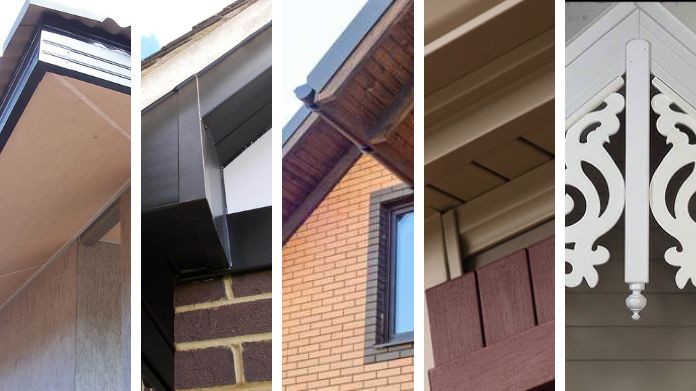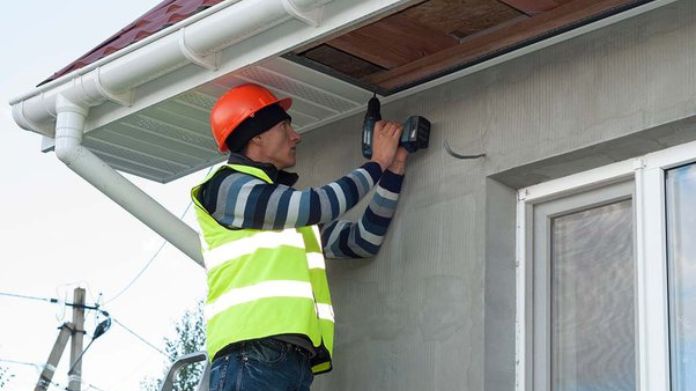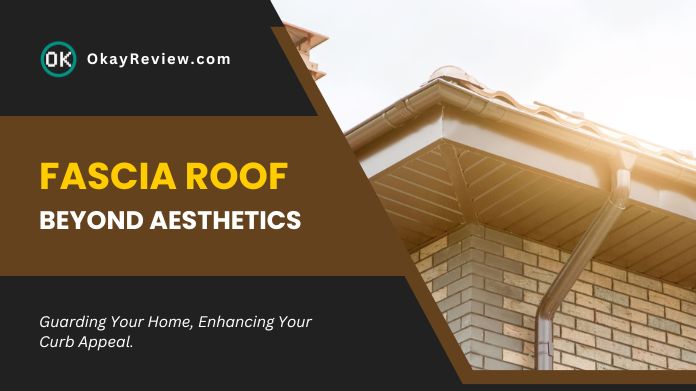Ever gazed up at a house and admired its sleek roofline, unaware of the silent protector at work? That’s the fascia roof for you—a subtle yet crucial component of home architecture.
Beyond its aesthetic appeal, this roof is a formidable shield, defending our homes from nature’s whims.
In this exploration, we’ll delve into the intricacies of the fascia roof, shedding light on its importance and why every homeowner should be attuned to its role.
While a well-maintained fascia roof is essential, let’s not forget about the revolutionary advancements in interior design, like magnetic flooring.
Join us as we uncover the story behind this architectural marvel.
Table of Contents
What is the Fascia and Its Role in the Roof?
It is a vital component of any building’s architecture, often unnoticed by many. But what exactly is it, and why is it so crucial?
The fascia is a board that runs horizontally along the edge of a roof. It’s the finishing touch that connects the roof to the outer walls of the house, giving the roofline a smooth, continuous appearance.
But the fascia roof is not just about aesthetics; it plays a pivotal role in protecting your home. One of the primary functions of the roof is to act as a barrier against external elements.
It safeguards the house from water, wind, and pests, ensuring that these threats don’t seep into the more vulnerable parts of the structure. Doing so helps prevent damage to the wooden rafters and the house’s interior.
While the fascia plays a crucial role in protecting your roof, it’s equally important to explore the secret weapon of roof scuppers.
Moreover, it provides structural support to the gutters. Without the fascia, the gutters, which channel rainwater away from the house, would lack a sturdy base, leading to potential water damage to the property.
Materials Used for Fascia Roof
Let’s delve into the various materials commonly used for the roof and their unique attributes.
- Wood: A classic choice for many homeowners, wood offers a natural and timeless look. Whether it’s cedar, redwood, pine, or fir, wooden fascia roofs can be painted or stained to match the exterior of the house. However, it’s essential to seal wooden fascia against moisture to prevent rotting or decay.
- Aluminum: A modern alternative, aluminum fascia roofs are known for their durability and minimal maintenance. Resistant to rust, corrosion, and rot, aluminum provides a sleek finish that can elevate a home’s curb appeal. It’s a perfect choice for areas prone to heavy rainfall or snow.
- PVC: PVC fascia roofs have gained popularity due to their resistance to decay, warping, insects, and moisture. They don’t require painting or staining and are available in various sizes and colors. However, homeowners should know about potential expansion and contraction in extreme temperatures.
- Vinyl: An affordable and low-maintenance option, vinyl fascia roofs offer moisture protection and improved appearance. While they are cost-effective, vinyl can become brittle in extreme weather conditions.
- Fiber Cement: Known for its strength and resistance against environmental damage, fiber cement is a robust choice for fascia roofs. It suits various architectural styles and requires little upkeep, though it might be pricier.
Types of Roofing Fascia
 There are different types of fascia roofs tailored to various architectural needs and styles. Let’s explore these types to understand their unique characteristics and applications better.
There are different types of fascia roofs tailored to various architectural needs and styles. Let’s explore these types to understand their unique characteristics and applications better.
1. Gable Fascia
It extends along the slanted margins of a gable roof. Gable fascia often extends from the eaves to the roof’s peak, creating a continuous line that adds to the structure’s visual appeal.
Especially in older or Victorian-style homes, gable fascia might feature ornate designs or curved ends, adding a touch of elegance.
2. Eave Fascia
Positioned under the eaves, eave fascia is typically straightforward in design. Its primary role is to seal the ends of the rafters and provide a flat, sturdy surface for attaching gutters.
This type of fascia roof ensures that rainwater flows seamlessly into the gutters, preventing potential water damage to the property.
3. Smooth Fascia
As the name suggests, smooth fascia roofs offer a sleek and polished look. They are often paired with modern homes featuring smooth siding, brick, or stucco. The clean lines of smooth fascia enhance the contemporary feel of a building.
4. Rough-Sawn Fascia
Perfect for homes with a rustic or traditional design, rough-sawn fascia roofs have a textured finish.
They are an excellent match for exteriors with T1-11 plywood, cedar shakes, or other rugged materials, adding to the home’s character.
5. Ornamental Fascia
For those looking to make a statement, ornamental fascia roofs have intricate designs and patterns.
They can be custom-made to align with the architectural style of the house, ensuring that the fascia roof is not just functional but also a work of art.
Function and Importance of Fascia
Let’s delve deeper into the function and importance of the fascia roof.
- Protection Against External Elements: The fascia roof serves as a protective barrier, shielding the home from water, wind, and pests. This protection prevents damage to the structure’s wooden rafters and interior.
- Support for Gutters: It offers a sturdy surface vital for gutter attachment. Without fascia, gutters lack stability, risking water damage to the property. Thus, the fascia roof is crucial in directing rainwater and protecting the home’s foundation.
- Aesthetic Appeal: Beyond its practical roles, the fascia roof elevates a building’s aesthetics. It seamlessly connects the roof to the walls, providing visual harmony. Depending on its finish, the fascia roof can be adapted to match the home’s architectural style.
- Prevention of Moisture Damage: It protects the rafter ends from moisture, which is essential in areas with heavy rain or snow to prevent rot, mold, and structural issues.
- Enhanced Structural Integrity: The fascia roof strengthens the lower edges of roof tiles or shingles, ensuring they stay in place during harsh weather and enhancing the building’s structural integrity.
Attaching and Maintaining Fascia
 Ensuring that the fascia roof is properly affixed and well-maintained is pivotal for the overall health and appearance of a home.
Ensuring that the fascia roof is properly affixed and well-maintained is pivotal for the overall health and appearance of a home.
Let’s explore the steps and considerations involved in attaching and upkeeping the fascia roof.
Attaching the Fascia Roof:
- Preparation: Before attaching the fascia roof, it’s essential to ensure that the rafters are level and free from protruding nails or debris. This provides a smooth surface for the fascia to adhere to.
- Measurement and Cutting: Measure the length of the roofline where the fascia will be attached. Cut the fascia board to the required length, ensuring precision for a snug fit.
- Securing the Fascia: Using rust-resistant nails or screws, securely fasten the fascia board to the ends of the rafters. It’s crucial to space the fasteners evenly and ensure they penetrate deep enough into the rafters for a firm hold.
- Sealing the Edges: Once attached, seal the edges of the fascia roof to prevent moisture infiltration, which can lead to rotting or warping.
Maintaining the Fascia Roof:
- Regular Inspection: Periodically inspect the fascia roof for signs of damage, rot, or pest infestation. Early detection can prevent minor issues from escalating into major problems.
- Cleaning: Over time, the fascia roof can accumulate dirt, mold, or mildew. Gently clean it using a soft brush and a mixture of water and mild detergent. Ensure it’s rinsed thoroughly and allowed to dry.
- Repainting or Resealing: If the fascia roof is made of wood, consider repainting or resealing it every few years to protect against moisture and UV damage. It not only prolongs the life of the fascia but also enhances its appearance.
- Checking Fasteners: Ensure that the nails or screws holding the fascia roof in place are not loose or corroded. Replace any compromised fasteners to maintain the fascia’s stability.
- Gutter Maintenance: Because this roof frequently holds gutters, ensure they are clean and free of clogs. It prevents water from overflowing and damaging the fascia.
Conclusion
It is more than just a decorative trim; it’s a protective barrier that plays a pivotal role in maintaining the structural integrity and appearance of a home. By understanding its importance and ensuring its proper care, homeowners can ensure the longevity and beauty of their homes.


Informative read! Fascia boards protect the roof and enhance the home’s appearance. Do you have any recommendations for the best durable materials in extreme weather conditions?